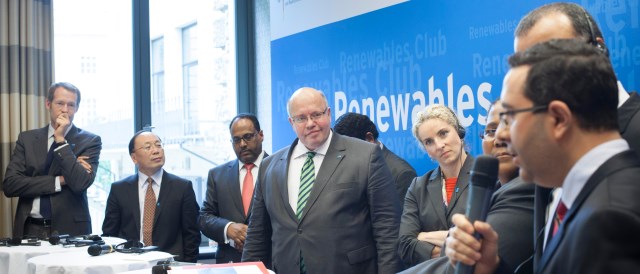What exactly would a new Renewables Club focus on? Today, Craig Morris takes a look at the World Resource Institute’s proposals, which he finds convincing. But he still has one question.

What could they talk about? (BMU/Ute Grabowsky, photothek.net)
In its call for a Solar Economy Club (PDF), the WRI breaks up the project into three phases. The first one would begin by addressing trade issues. The solar trade war has made a lot of headlines, but in general governments like to focus on domestic content in promoting renewables, so the issue is not just limited to solar. The study says that a club would give members a place to amicably negotiate levels of domestic industry support – and to have disputes at least discussed without having to involve the World Trade Organization. Nonetheless, the study acknowledges that the club’s decisions would still be subject to international trade rules; for instance, if Germany took leadership of the club, it would still have to comply with EU law. But Germany and China, which are both suffering from surplus capacity in the solar sector, could work with third countries to step up other markets in order to remedy the industry’s situation in both countries.
The second phase would focus on developing markets, and the WRI has a proposal that might surprise some of our readers: feed-in tariffs (FITs). Because FITs have long been associated with solar in the English-speaking world, some have claimed that no more policy support – and hence, no more feed-in tariffs – will be needed when photovoltaics costs the same as retail electricity (“grid parity”). Increasingly, grid parity is being reached – so why call for feed-in tariffs now?
Basically, feed-in tariffs ensure that the cost impact of investments in renewables remains in check; they generally offer a return of 5-7%, whereas new German solar has a return of nearly 100% relative to the retail rate (the highest PV feed-in tariff is now around 15 cents, compared to retail rates of around 28 cents). Nonetheless, the WRI says that developing countries might still be unable to finance feed-in tariffs, so some help for wealthier club members could be provided.
The third and final phase would go beyond ending trade disputes and work on binding standards that would facilitate trade between club members. As the study points out, the world has been working to remedy the trade barrier situation for the past decade (at least since Doha in 2011), and some estimates put the cost of trade tariffs on renewables projects “already at zero.” But other barriers, such as differing standards and certification, still exist; only recently, the UK implemented a special certification requirement when it launched feed-in tariffs for solar, sending solar firms already established in numerous other countries scrambling to get this special certification. So in the third phase, trade barriers would be turned into trade preferences through coordination and harmonization of standards.
Obviously, I cannot do justice to the 36-page report in the space I have here, so see the study for yourself. But one question lingers in my mind – why can’t the existing organizations already do this?
Craig Morris (@PPchef) is the lead author of German Energy Transition. He directs Petite Planète and writes every workday for Renewables International.